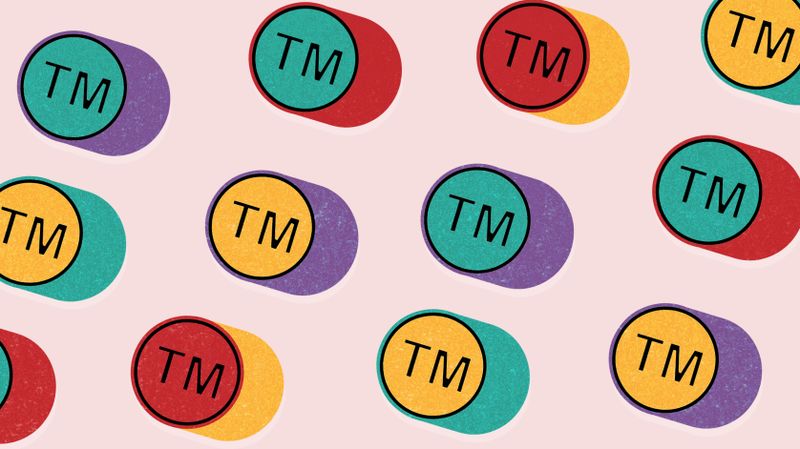Ever wonder how celebrity beauty brands get leaked months or even years before they’re actually released?
It’s called trademarking, and it’s a legal process that indicates the true source of a product in order to distinguish it from other similar brands. A trademark can take shape in a brand mark or symbol, such as a logo, a brand name, and even a brand tagline. In simple terms, it’s like the government’s version of a verified checkmark on a product or brand name.
SEE ALSO: Is this the end of celebrity beauty brands?
When a brand files a trademark, by law it is required to be publicly listed on a trademarking database that can be accessed by anyone, such as Justia Trademarks. New filings are typically how upcoming cosmetic product launches make headlines before they’re announced. For example, the new Kim Kardashian skincare collection, SKKN by Kim Kardashian, and Hailey Bieber’s beauty brand, Rhode, were both leaked earlier this year via a trademark filing.
What is a trademark?
For businesses across all industries, protecting their brand is extremely important. This allows them to claim the rights of their unique product, minimizing copies, dupes, and potential future lawsuits. Businesses that want to protect their brand can file a trademark.
“It is the most effective tool a business can use to create customer recognition,” trademark lawyer Heather Antoine tells Very Good Light.
According to the U.S. Patent and Trademark Office (USPTO),
A trademark is a word, name, symbol, or device that is used in trade with goods to indicate the source of the goods and to distinguish them from the goods of others…. Trademark rights may be used to prevent others from using a confusingly similar mark, but not to prevent others from making the same goods or from selling the same goods or services under a clearly different mark. Trademarks allow makeup brands to have their own logos, packaging, and compact and applicator designs.
If a company has an active trademark protecting its products, the company may litigate if another brand is creating a similar product.
In 2018, Kylie Jenner hit a snag when launching her 21st birthday collection which featured glitter shadows, including one with the name “Born to Sparkle.” The beauty brand Sheree Cosmetics was quick to file a lawsuit against Kylie, claiming her brand was infringing on their trademark of the tagline, “Born to Sparkle.”
Sheree Cosmetics filed a trademark on the tagline before releasing their eyeshadow palette of the same name. Since they trademarked the name first, there’s a chance that consumers who search “born to sparkle eyeshadow palette” are looking for the product by Sheree Cosmetics and are instead brought to Kylie’s palette.
This happens far too often, which is why brands file trademarks long before product launches to protect the rights of future products. That is how consumers are made aware of upcoming releases like Fenty Hair by Rihanna, Kris Jenner Cosmetics, and even Kylie Baby by Kylie Jenner, which was filed in 2019.
Aside from trademarking a name and slogan, companies have increasingly trademarked random slogans and tag lines since filing a trademark is like a race. Brands swoop up taglines to either stake their claim before anyone else and be the first to market with a new popular phrase, or hold it for ransom so other companies have to pay a higher price in order to acquire the trademark.
For example, the beauty brand C’est Moi has trademarked slogans such as “Thoughtfully Formulated” and “A New Generation of Clean Beauty,” which are seemingly meaningless phrases, but prevents other larger beauty brands from using these exact wording in their marketing.
The benefits of trademarking
But beyond filing a trademark for a brand’s name and logo, brands can also protect unique elements of their products. La Mer has a trademark for the secret “miracle broth” ingredient featured throughout the brand’s assortment of products.
While brands can and most often file trademarks on proprietary information related to their brand, they can also file trademarks in order to block other brands from getting trademarks that would be beneficial to their business. The filing date for a trademark is important. This is because the date that your trademark is registered, also known as a priority date, is the earliest date a trademark owner can rely on to claim their established rights.
What exactly can brands trademark?
When building a brand and beginning the naming process, trademark attorney Heather Antoine recommends that founders keep in mind how crowded the marketplace already is.
“Generally speaking, beauty brands should consider protecting their name, logo, and/or slogan,” she says. “But anything that functions as a ‘source identifier or reminds the consumer of a particular brand, can function as a trademark.”
This can range from color, such as Tiffany Blue, scent such as Play-Doh, and even sounds such as the lion roar from MGM. One grey area, however, lies with shade names, as seen in the Kylie Cosmetics “Born to Sparkle” lawsuit.
“While the shade name itself may or may not be protectable, beauty brands should be wary of using shade names that potentially infringe on someone else’s trademarks or right of publicity.”
Heather recommends that a brand name be invented and should not be a word that exists in the dictionary. Brands with unique names can maximize their impact and chance of being remembered by consumers by adopting a tagline or slogan to describe the product or service. The tagline will give insight into what product or service the trademark refers to.
Something to avoid when filing a trademark is generic words. For example, a lipstick line called “lipstick” would not be entitled to any trademark protection.
Filing a trademark
The process of filing a trademark varies and depends on a number of factors, including whether the trademark is currently being used or not. “As a practice, we always run a knockout search before filing an application,” says Heather. “A knockout search is a high-level review to see if there are any applications or registrations that could be cited against us.”
After filing an application it can typically take three months for a trademark examiner to be assigned to review the application. Once in the hands of an examiner, the trademark office will then either issue an office action, which is when they believe something is wrong with the application, or the application will be cleared for publication. Assuming the trademark makes it through publication without any opposition, registration will be issued.
“The process takes about nine months at a minimum, and can last as long as a few years,” says Heather.
Enforcing trademarks
Just because brands have a registered trademark doesn’t mean they’re not at risk for other brands infringing on their property. It is up to the business to monitor and enforce the use of the trademark.
“The benefits [of a registered trademark] are both offensive and defensive in nature and undoubtedly one of the most important decisions a business makes,” says Heather.
If a registered trademark has had five years of continuous and exclusive use, the trademark can become “incontestable,” which means certain aspects of the trademark cannot be challenged. Brands have the right to use the ® symbol, which puts the public on notice that the trademark is registered.






